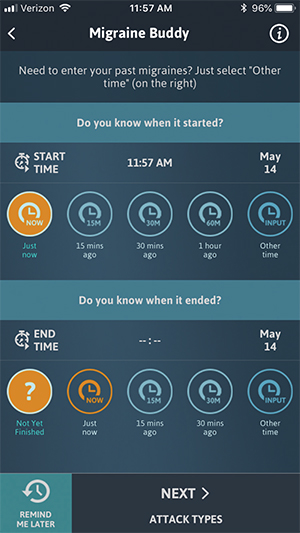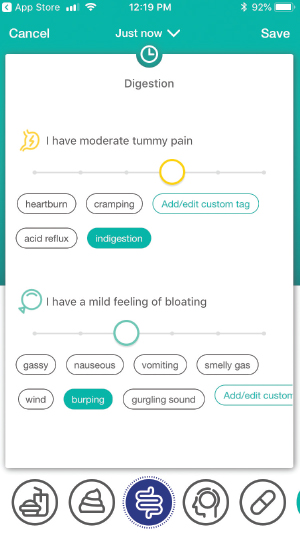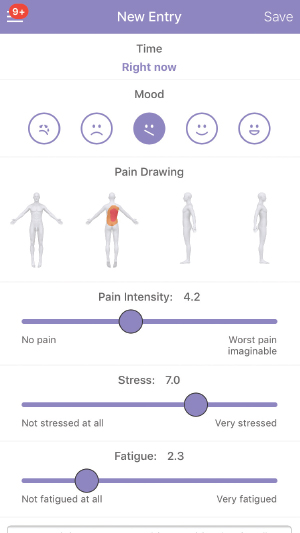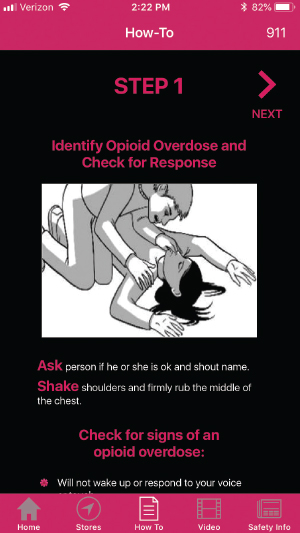
These apps can help you and your patients more effectively manage their acute and chronic pain.
Fam Pract Manag. 2018;25(4):oa1-oa4
Author disclosure: no relevant financial affiliations disclosed.
Family physicians regularly help patients deal with acute and chronic pain. One study estimated that more than 126 million people in the United States had reported some level of pain in the previous three months and that 25 million people suffer from daily pain – often quite severe.1 Patients in severe pain tend to have worse health statuses and more disability.
Mobile devices can help patients better understand the causes of their pain, which can help them better cope with their conditions, and provide you with data you need to recommend or alter treatment. To help you guide patients to the best apps, this article focuses on four that earned top ratings when reviewed using FPM's “SPPACES” criteria.
APP REVIEW CRITERIA
S — Source or developer of app
P — Platforms available
P — Pertinence to primary care practice
A — Authoritativeness/accuracy/currency of information
C — Cost
E — Ease of use
S — Sponsor(s)
MIGRAINE BUDDY
Migraine Buddy is a headache diary that allows patients who experience migraine headaches to monitor the conditions that lead to an attack and influence its severity.

Source: Healint.
Platforms available: Android 4.0.3 or later (https://bit.ly/Wj5MiW); iOS 9.0 or later for iPhone, iPad, and iPod touch (https://apple.co/2I8gJjH).
Pertinence to primary care practice: Migraine Buddy increases patient engagement and helps patients become more cognizant of how migraine attacks start and how to treat them. It also allows patients to provide their physician with a summary of migraine symptoms, frequency, and previous treatments.
Authoritativeness/accuracy/currency of information: The user can track migraine triggers, associated symptoms, frequency, duration, intensity, location, and alleviating factors. The app automatically tracks sleep, weather, air pressure, motion, and fitness. Designed by neurologists and data scientists, Migraine Buddy stores all data in a HIPAA-compliant cloud. The app has been featured by various newspapers, magazines, and websites, although it has not been evaluated in the literature for efficacy. It is one of many migraine-focused apps.2 The app was last updated in June 2018 (Android and iOS).
Cost: Free.
Ease of use: Users can quickly and easily record an attack using the app's diagrams and questionnaire. If the user is unable to record all information at the time of the attack, the app allows him or her to skip certain entries and will remind the user to finish later. The content is available in English, Dutch, French, German, Italian, Japanese, Portuguese, and Spanish.
Sponsor: Healint.
Rating:

Migraine Buddy is a great app that helps patients gain insight into their migraine triggers and the most useful treatments.
CARA
Cara (a “food, mood, poop tracker”) is a health diary designed to help patients monitor and manage gastrointestinal symptoms in relationship to their diet, medications, mood, and activity.

Source: HiDoc Technologies GmbH. Platforms available: iOS 10.0 or later for iPhone, iPad, and iPod touch (https://apple.co/2wDruVV). An Android version is under development.
Pertinence to primary care practice: Determining triggers and managing irritable bowel syndrome, chronic abdominal pain, and inflammatory bowel disease can be challenging for both patients and providers. Cara can make this less stressful.
Authoritativeness/ accuracy/currency of information: Cara was developed by a group that includes a physician. It allows users to log their food intake, Bristol stool scale, digestive symptoms, mood symptoms, stress, menses, physical activity, sleep, pain, and medication use. Users can monitor their symptoms over time with the tracking tools in the app. They can use this information to also see how their activity and stress levels affect their symptoms. User data is stored on encrypted servers. The app was last updated in May 2018.
Cost: Free.
Ease of use: Users can save favorite meals and export data to their physician as a PDF or CVS file. Logging data takes less than one minute. All of the menus are easy to read and use. Cara is available in English and German.
Sponsor: HiDoc Technologies GmbH.
Rating:

Cara is an important app for those with gastrointestinal issues to better monitor their triggers and manage their symptoms.
PAIN COMPANION
Pain Companion helps patients log their pain and learn exacerbating as well as alleviating factors.

Source: Sanovation AG.
Platforms available: Android 4.1 or later (https://bit.ly/2IDCAiu); iOS 8.0 or later for iPhone, iPad, and iPod touch (https://apple.co/2rGi2Ly).
Pertinence to primary care practice: Chronic pain is a common concern in primary care, but keeping track of the nature of patients' pain and what alleviates it can be burdensome. Patients often are unaware of psychological aspects that can affect their pain. This app allows users to record this data and provide it to their physicians in a logical, concise format to aid in their treatment.
Authoritativeness/ accuracy/currency of information: Users can make detailed color anatomical drawings with the app that show the intensity and location of the pain, and they can track associated symptoms. Unfortunately, it does not appear that the app included physician input during its creation, a common factor with pain apps.3 The app was last updated in September 2016 (Android and iOS).
Cost: Free, but the makers do ask for voluntary paid subscriptions between 99 cents and $9.49 a month.
Ease of use: Patients can use the app to export pain diaries, view detailed charts and statistics about their pain, and communicate through private messages with others with similar medical conditions or pain. The content is available in English only.
Sponsor: Sanovation AG.
Rating:

Pain Companion is a convenient and meaningful way for patients to record and manage their chronic pain.
NARCAN NOW
Narcan Now explains the indications of and how to use Narcan nasal spray.

Source: ADAPT Pharma Inc.
Platforms available: Android 4.1 or later (https://bit. ly/2IjxdkU); iOS 9.0 or later for iPhone, iPad, and iPod touch (https://apple. co/2IkmaME).
Pertinence to primary care practice: Patients taking more than 90 morphine milligram equivalents (MME) of opioids daily or using heroin are at risk of an overdose.
Narcan, if properly used, can reverse an opioid overdose and save lives. Many physicians and patients are not familiar with how to use Narcan, a knowledge gap this app can fill.
Authoritativeness/accuracy/currency of information: The app outlines Narcan indications and safety information, explains how to identify opioid overdose, and offers video and written/pictographic instructions on how to administer nasal Narcan. Users can use the app to identify a local pharmacy that sells Narcan as well as tap a button to call 911. The app was last updated in February 2018 (Android and iOS).
Cost: Free.
Ease of use: Narcan Now is simple to use, even in a crisis situation. Users can easily navigate to key information in seconds. The app is available in English only.
Sponsor: ADAPT Pharma Inc.
Rating:

Narcan Now is an essential app for patients at risk of opioid overdose and those who want to help in the event of one.
